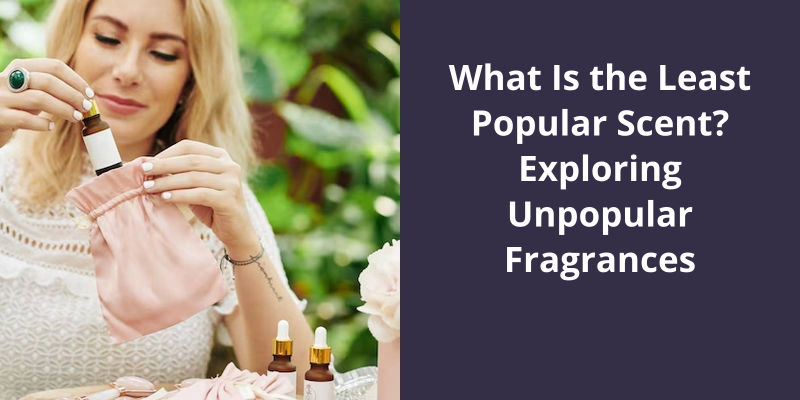Identifying the least popular scent can be subjective as people’s preferences for fragrances vary greatly. However, musky scents are often found to be less favoured in the fragrance market – likely due to their strong, overpowering nature that isn’t loved by all. Notes like cumin, which are often associated with body odor, and scents that replicate the smell of certain foods such as durian, are also relatively unpopular. While some individuals may enjoy these unique scents, they are generally less sought after compared to fresh, floral, or sweet fragrances. Nevertheless, it’s worth noting that scent preferences can change over time and can also be influenced by cultural, regional, and personal factors.

What Is the Most Attractive Scent in the World?
The sense of smell is closely associated with memory, emotions, and overall wellbeing. With more than 1,000 scents identified by science, it’s not surprising that people may have different preferences. Nevertheless, a recent study conducted by Dr. Alan Hirsch and his team of researchers found that the most attractive scent in the world is vanilla.
Vanilla has a sweet, warm, and comforting aroma that people usually associate with food or dessert. Vanilla is ubiquitous in many products, from food and beverages to fragrances and cosmetics. Vanilla is extracted from the pods of a tropical orchid plant, and it’s essence is a complex mixture of compounds such as vanillin, coumarin, and eugenol.
The researchers conducted a study where they presented ten scents to 1,600 participants and asked them to rank the scents from most to least pleasant. The scents included lavender, cinnamon, peppermint, lemon, orange, pine, cherry, soap, musk, and vanilla. Vanilla ranked first, with 35% of participants liking it’s scent the most, while lavender ranked second with 16% of participants preferring it’s scent.
The study also found that vanilla has a calming effect on people, reducing their levels of stress and anxiety.
It’s sweet, comforting, and calming aroma has a significant impact on peoples mood and wellbeing.
The History of Vanilla: How It Became the World’s Most Popular Flavor and Fragrance
Vanilla has a rich history dating back to the ancient Mayan and Aztec civilizations. It was first introduced to Europe in the 16th century and quickly became a popular flavor and fragrance. Today, vanilla is used in a wide range of products from ice cream to perfume and continues to be one of the most desired and beloved flavors in the world.
As humans, we’ve many favorite smells that evoke happy memories, remind us of certain seasons, or simply make us feel good. While some may argue that the best smell is subjective and depends on personal preferences, there are a few scents that are universally beloved. In this article, we will explore the top eight best smells in the world, from the freshness of the great outdoors to the warm aroma of melted chocolate.
What Is the Number 1 Best Smell?
The sense of smell is one of the most powerful and evocative senses that we possess. It’s strongly linked to our emotions, our memories, and our overall well-being. Smells can influence our moods, transport us to different times and places, and even have a physical impact on our bodies. With so many different smells in the world, it can be difficult to determine which one is the best, but there’s one smell that stands out above the rest: fresh air.
Fresh air is the quintessential smell of nature. It encompasses all of the things that we love about the great outdoors. The scent of rain on the ground, the earthy smell of the forest floor, the fragrant breath of a flower – all of these things contribute to the overall freshness of the air.
Another smell that’s often cited as one of the best is vanilla. There’s something warm and comforting about the scent of vanilla, which is why it’s often used in candles, perfumes, and other products. It’s a sweet and creamy aroma that can evoke feelings of relaxation and happiness. Vanilla is also commonly associated with baked goods, so the smell can remind us of home, family, and good times.
For many people, the smell of coffee is the best smell in the world. The rich, roasted aroma of coffee beans can perk up our senses and give us a much-needed boost in the morning. Coffee can also be associated with socializing and meeting friends, so the smell can bring back happy memories of good times spent with loved ones.
Barbecue is another smell that often manages to make the list of best smells in the world. It’s the smoky, savory aroma of grilled meat, and it can be difficult to resist. Barbecue is often associated with summertime, outdoor gatherings, and good times with friends and family. The smell can make our mouths water and can make us feel happy and content.
The smell of campfires is another one that many people love. It’s the earthy, smoky scent of burning wood, and it can remind us of camping trips, roasting marshmallows, and spending time in the great outdoors. The smell can be comforting and relaxing, and it can transport us to a different time and place.
Finally, the smell of rain is one that many people find incredibly refreshing and invigorating. The scent of rain on the ground is a combination of various fragrances, including wet earth, fresh grass, and blooming flowers. It’s a natural and soothing scent that can make us feel alive and refreshed.
The history of scent and perfume dates back thousands of years, with ancient civilizations experimenting with various natural ingredients to create pleasing fragrances. While many of these scents have been lost to time, some have persisted and continue to be used in modern perfumery. In this article, we’ll explore the origins of perfume and take a closer look at the oldest scent on record.
What Is the Oldest Scent?
However, these perfumes weren’t the earliest scents known to humans. In fact, the oldest scent goes back much further in time than ancient Greece. It’s believed that the oldest scent known to humans can be traced back to the era of Neanderthals, who lived more than 40,000 years ago.
Neanderthals are known to have used plants, specifically those with medicinal properties, for various purposes including healing and embalming. The use of plants for their scent is believed to have emerged much later during the Bronze Age.
Ancient Egyptians were renowned for their use of perfumes, which were used not only for aesthetic purposes but also as part of religious rituals. They used a variety of scents including cinnamon, myrrh, and frankincense, which were believed to have mystical properties.
Today, the perfume industry has reached new heights, with countless scents available for both men and women. These scents are created using a variety of natural and synthetic ingredients, and are marketed and sold worldwide. Despite the advancements made in the science of scent, the ancient practice of perfumery still holds a place of importance in human culture and history.
Conclusion
In conclusion, while scent preferences are subjective and heavily influenced by culture and personal experience, it seems that isovaleric acid is widely considered to be the least liked scent among humans. This compound, although naturally occurring in certain foods and bodily secretions, carries a pungent and unpleasant odor that many find unappealing. Interestingly, despite being the least popular scent, isovaleric acid has also been used as an attractant for pests such as mosquitoes and ticks. Understanding the science behind scent preferences and aversions can help us better appreciate the complexities of the human sensory experience and provide insights into the evolution of our sense of smell.





